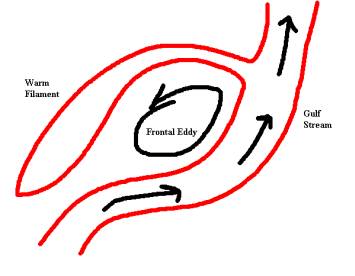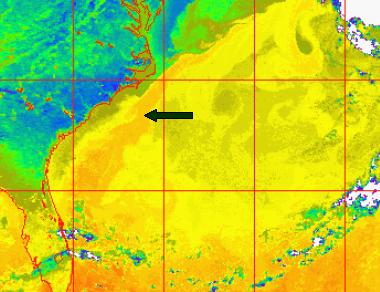OC4331-Mesoscale
Oceanography
Final Project Summary
Topic Area
Final Project Summary
Gulf Stream
Frontal Eddies
Project Team Member(s)
LT Karen Wingeart,
USNMajor Findings
Gulf
stream frontal eddies are cold cyclonic features that form in troughs of
northward propagating Gulf Stream meanders in the South Atlantic Bight
(Figure 1).Ý A deep upwelled
cold dome forms along the western edge of the offshore meander and a shallow
warm filament extends southward along the shoreward side of the cold dome.Ý Previous
studies concluded the following frontal eddy characteristics:
- Form downstream of the Charleston Bump
- Average size: 150km alongshore by 50 km cross-shore diameter
- Average propagation: 24 km/day
- Average recurrence: 6 days
- Cyclonic circulation extends throughout the water column
- Temperature anomaly of cold core is greatest at depth
The
Frontal Eddy Dynamics Experiment (FRED) was conducted offshore North Carolina
between Cape Fear and Cape Hatteras from May through November 1987.Ý AVHRR
Satellite imagery was used to locate frontal eddies.Ý Other
measurements taken included shipboard and aircraft XBT/AXBT surveys, acoustic
doppler current profiler data, Argos-tracked drifting buoys data, and surface
salinity samples.Ý Eddy Abbott
was the first and most intensively sampled frontal eddy surveyed (Figure
2).Ý It was tracked from 9-19
May and is the first eddy to be seeded with buoys and tracked past Cape
Hatteras.Ý Typical 150m temperatures
upstream and downstream of the cold dome were 17°-18°C.ÝThe
evolution of Eddy Abbott's passage was as follows:
- Warm temperatures and strong down stream flow within the meander crest exist
- As cold dome approaches, temperature and alongshore flow decrease greatly
- At passage, temperature warms, alongshore flow increases, and cross-shore flow switches from onshore to weaker offshore
- After passage, warm downstream alongshore flow occurs in trailing meander crest
- Warm filament detaches and remains in Raleigh Bay
- Eddy propagates NE past Cape Hatteras and new warm filament develops
FRED
experiment concluded that frontal eddies propagate along the North Carolina
Coast every 4-5 days and they are associated with small and large mode
Gulf Stream meanders.Ý Contrary
to previous study results, the North Carolina Shelf is not a graveyard
for frontal eddies.Ý Eddy Abbott's
cold dome survived past Cape Hatteras.

Figure 1. Typical Gulf Stream frontal eddy formed in meander with warm
filament extending shoreward.

Figure 2. AVHRR image of Eddy Abbott located off Cape Fear on 10 May 1987.
References
Glenn,
S.M., and C.C. Ebbesmeyer, 1994: "The structure and propagation of a Gulf
Stream frontal eddy along the North Carolina shelf break." J. Geophys.
Res.,
Vol. 99, 5029-5046.